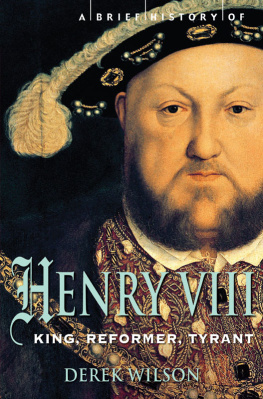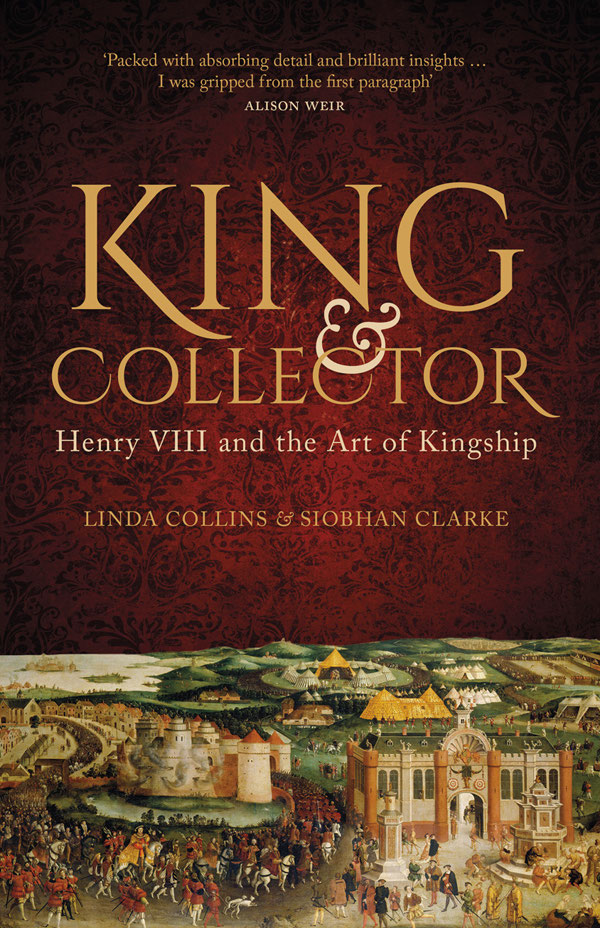Linda Collins: With thanks to my husband John for his invaluable support and endless cups of tea.
Siobhan Clarke: To my darling, Roger Pheby, for your encouragement and endurance of all things Henry.
First published 2021
The History Press
97 St Georges Place, Cheltenham,
Gloucestershire, GL50 3QB
www.thehistorypress.co.uk
Linda Collins & Siobhan Clarke 2021
The right of Linda Collins & Siobhan Clarke to be identified as the Authors of this work has been asserted in accordance with the Copyright, Designs and Patents Act 1988.
All rights reserved. No part of this book may be reprinted or reproduced or utilised in any form or by any electronic, mechanical or other means, now known or hereafter invented, including photocopying and recording, or in any information storage or retrieval system, without the permission in writing from the Publishers.
British Library Cataloguing in Publication Data.
A catalogue record for this book is available from the British Library.
ISBN 978 0 7509 9624 2
Typesetting and origination by The History Press
Printed in Turkey by Imak
eBook converted by Geethik Technologies
CONTENTS
LIST OF ILLUSTRATIONS
FOREWORD
BY FLORIAN SCHWEIZER
Learning about the arts should always be an enriching and satisfying experience. Crucial to that experience are inspiring narrators who can breathe life into the stories of the past that are captured in art and material culture. It is a real joy to be in the presence of experts who not only understand their subject matter but also the audience they are sharing their knowledge with. Patricia Fay, the founder of The Arts Society, always insisted that learning should be enjoyable. This is still an ideal we aspire to in all we do at The Arts Society today, and in this book we find much that readers will enjoy.
Linda Collins and Siobhan Clarke bring a magnificent and dreadful king to life through the visual medium of his paintings, and in doing so create an impression of knowing the man more intimately. Henry VIII left a collection of not just valuable gold and jewels, but smaller and more personal items such as toothpicks and bandages for his legs.
Holbeins drawings of Henrys court create the cast of a Tudor play in which the twists and turns of the plot were often deadly. We can look into the faces of men and women whose last memory before facing the scaffold may well have been the cold and frigid eyes of King Henry himself.
To read this book is to become more personally acquainted with this tyrannical Tudor king through images of him painted by the people who knew him.
The Art of Kingship is indeed an apt subtitle for this little book that offers us an enormous visual slice of Henrys life. It is presented in a human context of which Patricia Fay would almost certainly have approved.
Florian Schweizer
CEO, The Arts Society
FOREWORD
BY BRETT DOLMAN
Back in 1537, when Hans Holbein the Younger put down his brushes and paints and stood back to admire his latest creation, he would not have known that his portrait of Henry VIII, full-size and confrontational, staring down from the wall of the Whitehall Palace Privy Chamber, would become the most iconic royal portrait in English history.
Holbeins Henry VIII is immediately recognisable to us as a statement of the unforgiving, brutish power of the Tudor dynasty. We can look through and beyond the portrait (with the benefit of hindsight and from the distant safety of the twenty-first century) to uncover the terror and magnificence of the Tudor age. We can glimpse the luxurious hubris, the paranoid authority and the unforgiving justice of Henry VIIIs reign. Art reveals the past.
And Tudor art is more than just Holbeins portrait. The first half of the sixteenth century was a rich and revolutionary period when England attempted to embrace the Renaissance, enticing continental artists across the Channel to add cultural lustre and modernism to Henrys court. At the same time, teams of artists and craftsmen were employed on a startling range of artistic endeavours, from heraldic decoration to mural cycles celebrating the achievements of the Tudor monarchy.
This is a book about Tudor art, but also the stories within and around each artwork, from the history paintings that eulogised Henry VIIIs early military campaigns in France through to the Abraham tapestries, commissioned towards the end of his reign, that were as much a vindication of the Kings political and religious choices that shaped early modern England as they are stunning Renaissance artworks, still jewels in the Royal Collection and on display at Hampton Court Palace today.
In their account, the authors have succeeded where many others have failed. Art has not been reduced to mere illustration; it becomes an immersive gateway into an exploration of Tudor culture, political symbolism and spirituality. We also have a well-matched account of Henry himself the nature of his kingship, his ambitions, achievements, failures, frustrations and insecurities and we follow his path from ebullient masquer and triumphant jouster to the crippled, irascible tyrant. For Henry VIII, art was both an integral part of what has been called the swaggering theatre of court life and a personal statement about his magnificence, sophistication and dynastic power. He commissioned, collected and consumed art.
From the audacious scale and ambition of the ephemeral architecture on display at the Field of Cloth of Gold to the exquisite quality and detail of English miniature portraiture, this book traces the dazzling range of artistic achievements of Henry VIIIs reign, along with contextual and technical insights to help the reader navigate this very different visual world. Through the text and the artworks, we can glimpse a lost world of bejewelled courtiers and palaces drenched in the colour and symbolism of sixteenth-century art and craftsmanship, as well as understand what it meant to Henry VIII and the Tudor art of kingship.
Brett Dolman
Curator (Collections),
Historic Royal Palaces
INTRODUCTION
PICTURES AND PATTERNS OF A MERCILESS PRINCE
IF ALL THE PICTURES AND PATTERNS OF A MERCILESS PRINCE WERE LOST IN THE WORLD, THEY MIGHT ALL AGAIN BE PAINTED TO THE LIFE OUT OF THE STORY OF THIS KING
SIR WALTER RALEIGH
WHITEHALL PALACE, SPRING 1537. The assistants have stretched the drawing over the wall of the great privy chamber and pounced charcoal dust into holes they have pricked around the outline. Pigments and varnishes, purchased from London apothecaries, stand ready alongside an array of brushes, made from the hair of hogs and squirrels tails.
A 40-year-old foreigner crosses the chamber casually; he is accustomed to the magnificence of gilded panelling, costly tapestries, shining tiled floors and brilliant moulded ceilings. He is extremely well dressed for an artist, but this is no ordinary craftsman. There is a hush as he removes his fur-collared gown, changes into a paint-stained doublet and starts to roll up his linen shirtsleeves. Everyone stands back when the drawing is removed from the wall and the dots of charcoal left behind show the outline of a man, massive and menacing. Another hush. Hans Holbein is about to paint Henry VIII into history.

















